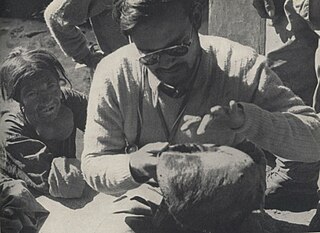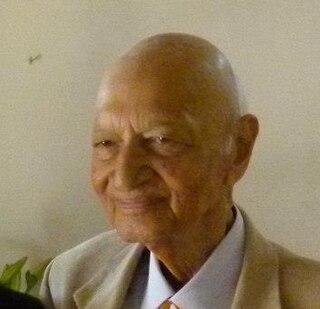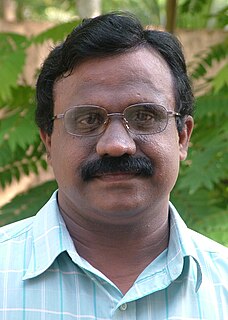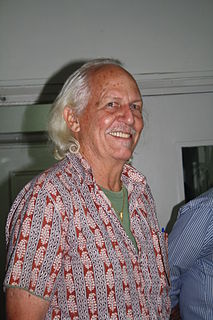 W
WHumayun Abdulali was an Indian ornithologist and biologist who was also a cousin of the "birdman of India", Salim Ali. Like other naturalists of his period, he took an initial interest in shikar (hunting). Unlike Sálim Ali, his main contributions were less field-oriented and based more on bird collections, particularly those at the Bombay Natural History Society where he worked for most of his life.
 W
WSálim Moizuddin Abdul Ali was an Indian ornithologist and naturalist. Sometimes referred to as the "Birdman of India", Salim Ali was the first Indian to conduct systematic bird surveys across India and wrote several bird books that popularized ornithology in India. He became a key figure behind the Bombay Natural History Society after 1947 and used his personal influence to garner government support for the organisation, create the Bharatpur bird sanctuary and prevent the destruction of what is now the Silent Valley National Park. Along with Sidney Dillon Ripley he wrote the landmark ten volume Handbook of the Birds of India and Pakistan, a second edition of which was completed after his death. He was awarded the Padma Bhushan in 1958 and the Padma Vibhushan in 1976, India's third and second highest civilian honours respectively. Several species of birds, a couple of bird sanctuaries and institutions have been named after him.
 W
WTarakad Vaidyanatha Ramakrishna Ayyar was a pioneer Indian entomologist who worked in the agricultural department in British India. He described numerous species of insect, especially the thrips, catalogued Indian insect pests, taught, and wrote a landmark textbook of entomology, the Handbook of Economic Entomology for South India (1940).
 W
WBiswamoy Biswas was an Indian ornithologist who was born in Calcutta, the son of a professor of Geology. In 1947, he was awarded a three-year fellowship by Sunderlal Hora, then director of the Zoological Survey of India (ZSI). It enabled him to study at the British Museum, at the Berlin Zoological Museum under Erwin Stresemann and also at the American Museum of Natural History under Ernst Mayr.
 W
WAshok Captain is an Indian herpetologist who has authored books and papers on Indian snakes. He was also a competing cyclist from 1977 to 1989. Captain's wood snake and Ashok's bronzeback tree snake have been named after him.
 W
WMaroli Krishnayya Chandrashekaran, also known as Shekar or MKC, was an Indian zoologist, regarded as the founder of Indian chronobiology, the study of biological rhythms of organisms. He was a fellow of the Indian Academy of Sciences, and the Third World Academy of Sciences, and in 1979 received the Shanti Swarup Bhatnagar Prize for Science and Technology. Born in Salem, Tamil Nadu, Chandrashekaran earned bachelor's and master's degrees in zoology at Presidency College, Chennai, and a PhD at the University of Madras. He served as editor of the Journal of Biosciences from 1991 to 1997 and Resonance: Journal of Science Education from 2003 to 2005.
 W
WDr B. J. Choubey was a scholar of Zoology and University professor at Tilka Manjhi Bhagalpur University. He is best known for his contribution in the field of endocrine research at University of Bhagalpur. He was a research student under the guidance of Dr. P. Thapliyal] at Banaras Hindu University.His scholarly publications have influenced many researchers in this field.
 W
WMargaret Bushby Lascelles Cockburn was an artist and amateur ornithologist who lived in the Nilgiris in India. She was born in Salem, India, and her father was the Collector of the District, M. D. Cockburn. The family initially visited Kotagiri in summer but settled permanently around 1855 at "Hope Park". Cockburn experimented on tea planting at Alports Estate and made numerous observations on local natural history and many of these were reported in the works of Allan Octavian Hume. She also made paintings of local birds and flora. The Natural History Museum, London, produced a diary in 2002 with illustrations made by her of the fauna and flora of the Kotagiri region. A collection of butterflies was also bequeathed to the Natural History Museum.
 W
WSister M. Cyril Mooney, IBVM is an internationally recognized educational innovator and the 2007 winner of the Padma Shri Award, the Government of India's fourth-highest civilian honor. She is a native of Ireland and a Sister of the Institute of the Blessed Virgin Mary (Loreto). Since 1956 she has been living and working in India, where she has emerged as a nationwide leader in bringing quality education to urban and rural poor children.
 W
WZafar Rashid Futehally was an Indian naturalist and conservationist best known for his work as the secretary of the Bombay Natural History Society and for the Newsletter for Birdwatchers a periodical that helped birdwatchers around India to communicate their observations. Awarded Padma Shri by the Government of India in the year 1971, Zafar Futehally was also honoured with Dutch order of merit the Order of the Golden Ark in 1981 and Karnataka Rajyotsava award by the Government of Karnataka in 1983.
 W
WAllan Octavian Hume, CB ICS was a British member of the Imperial Civil Service, a political reformer, ornithologist and botanist who worked in British India. He was one of the founders of the Indian National Congress. A notable ornithologist, Hume has been called "the Father of Indian Ornithology" and, by those who found him dogmatic, "the Pope of Indian ornithology".
 W
WVishwa Gopal Jhingran (1919–1991) was an Indian zoologist and aquaculture scientist, known for the introduction of a composite fish culture technique by name, aquaplosion. He was a recipient of the fourth highest Indian civilian award of Padma Shri from the Government of India in 1977.
 W
WP. Judson is an Indian Entomologist, who researched much on Dysdercus cingulatus in the 1970s. In the successive decades, he took to teaching of Zoology at Osmania University, Secunderabad, a State-run University u/s 2 (f) of the University Grants Commission Act, 1956. He contributed much to the discipline of Entomology through scholarly articles in scientific journals (see section on writings). He was also a member of the Indian Society for Comparative Animal Physiology.
 W
WSubhash Chandra Lakhotia is an Indian cytogeneticist, academic, Distinguished Professor of zoology, and INSA senior scientist at Banaras Hindu University. He is known for his pioneering researches on Drosophila with regard to its chromosome organization and replication. A Raja Ramanna fellow of the Department of Science and Technology and the Department of Atomic Energy, he is an elected fellow of all three major Indian science academies: Indian National Science Academy, Indian Academy of Sciences and National Academy of Sciences, India. The Council of Scientific and Industrial Research, the apex agency of the Government of India for scientific research, awarded him the Shanti Swarup Bhatnagar Prize for Science and Technology, one of the highest Indian science awards, in 1989, for his contributions to biological sciences.
 W
WThekke Curuppathe Narendran was an Indian entomologist specializing in the systematics of parasitic wasps in the superfamily Chalcidoidea (Hymenoptera).
 W
WK. K. Neelakantan better known by his pen name Induchoodan, was a leading Indian ornithologist. He is widely regarded as a pioneer of the environmental movement in Kerala for popularizing bird study through his books written in Malayalam.
 W
WKeshav Chandra Pandey, popularly known as K. C. Pandey, was an Indian educationist and zoologist with 55 years research experience, a Fellow of the Zoological Society of India (F.ZSI), and a Fellow of the Helminthological Society of India (FHSI).
 W
WUmesh Chandra Patra, also known as Dr. U. C. Patra was a zoologist, intellectual, scholar, professor and administrator from the state of Orissa, India. He was head of the Department of Zoology at Ravenshaw University. He started his teaching career as a lecturer in Zoology at Shri Krushna Chandra Gajapati College, Paralakhemundi and after a long stint at various government colleges, he retired from Ravenshaw University in 2001. He was a valuable member of the Zoological Society of Odisha State.
 W
WSainudeen Pattazhy is Associaate professor zoology, now working at the University of Kerala, Karyavattom Campus, Thiruvananthapuram who comes from Kerala, India.
 W
WK. S. R. Krishna Raju was an Indian ornithologist who worked extensively in the Eastern Ghats of Vishakapatnam. He conducted multiple avifaunal surveys, ringed birds and collaborated with other ornithologists including Dillon Ripley and Salim Ali. His studies provided weight to the Satpura hypothesis proposed by Sunder Lal Hora that the Eastern Ghats was part of a former continuum of habitats between the northeast of India and the Western Ghats with affinities to those in Southeast Asia. A subspecies of Abbott's babbler, Malacocincla abbotti krishnarajui, discovered around Visakhapatnam Ghats of Andhra Pradesh, was named in his honour, "for his efforts to promote the survey and conservation of the natural resources of the Eastern Ghats."
 W
WRam Brahma Sanyal was the first superintendent of the Alipore Zoological Gardens in Kolkata. He was a pioneer in captive breeding, and was one of the first zookeepers trained as a biologist. He was a corresponding member of the Zoological Society of London and wrote a handbook on keeping and breeding animals in captivity - A Handbook of the Management of Animals in Captivity in Lower Bengal (1892) which was reviewed in the journal Nature. This was the standard handbook for zookeepers for over 50 years until Lee Crandall published The Management of Wild Mammals in Captivity in 1964. His scientific methods led to the rare birth of a live Sumatran rhinoceros in 1889, an event that was not seen in captivity until 2001.
 W
WM. S. Balasubramania, popularly known as Snake Shyam, is a snake enthusiast, wildlife conservationist and lecturer in Mysore, India. He was elected to the Mysore City Corporation in 2013, a role he served until 2018.
 W
WLalji Singh FNA, FASc was an Indian scientist who worked in the field of DNA fingerprinting technology in India, where he was popularly known as the "Father of Indian DNA fingerprinting". Singh also worked in the areas of molecular basis of sex determination, wildlife conservation forensics and evolution and migration of humans. In 2004, he received the Padma Shri in recognition of his contribution to Indian science and technology.
 W
WRanbir Chander Sobti is an Indian educationist, cell biologist. He is a former vice chancellor of the Panjab University, Chandigarh and Babasaheb Bhimrao Ambedkar University, Lucknow. He is known to have involved in advanced research in plant genetic studies and has written over 240 articles, and 22 books including Essentials of Biotechnology and Emerging Trends in Biomedical Science and Health. He is an elected Fellow of several major science academies such as Indian National Science Academy, National Academy of Agricultural Sciences, National Academy of Medical Sciences, National Academy of Sciences, India, and Punjab Academy of Sciences. The Government of India awarded him the fourth highest civilian honour of the Padma Shri, in 2009, for his contributions to Literature and Education.
 W
WValmik Thapar is an Indian naturalist, conservationist and writer. He is the author of 14 books and several articles, and has produced a range of programmes for television. Today he is one of India's most respected wildlife experts and conservationists, having produced and narrated documentaries on India's natural habitat for such media as the BBC, Animal Planet, Discovery and National Geographic.
 W
WSunil Kumar Verma, is an Indian biologist and as of January 2018, a principal scientist at the Centre for Cellular and Molecular Biology, Hyderabad, India. Verma is primarily known for his contributions to the development of "universal primer technology", a first generation DNA barcoding method, that can identify any bird, fish, reptile or mammal from a small biological sample, and satisfy legal evidence requirements in a court of law. This technology has revitalised the field of wildlife forensics and is now routinely used across India to provide a species identification service in cases of wildlife crime. This approach of species identification is now known as "DNA barcoding" across the world.
 W
WVadayil Sankaran Vijayan is an Indian environmentalist, wildlife biologist, ornithologist, an admirer of naturopathy and the founding Director of the Salim Ali Centre for Ornithology and Natural History. He is currently the chairman of the Salim Ali Foundation[1].
 W
WMaharajadhiraj Mirza Maharao Sri Sir Vijayarajaji Khengarji Sawai Bahadur, GBE was the ruling Rao of Cutch from 1942 to his death in 1948.
 W
WRomulus Earl Whitaker is an Indian herpetologist, wildlife conservationist and founder of the Madras Snake Park, The Andaman and Nicobar Environment Trust (ANET), and the Madras Crocodile Bank Trust. In 2008, Whitaker was selected as an Associate Laureate in the 2008 Rolex Awards for Enterprise, for his efforts to create a network of rainforest research stations throughout India. In 2005 he was a winner of a Whitley Award for outstanding leadership in nature conservation. He used this award and found the Agumbe Rainforest Research Station in Karnataka, for the study of King Cobras and their habitat.